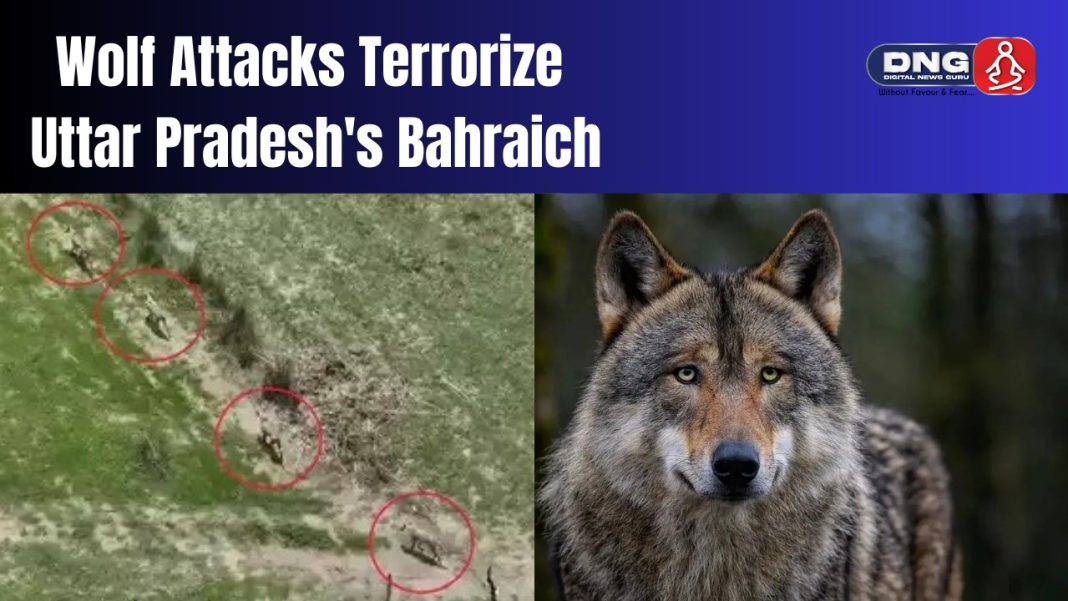DIGITAL NEWS GURU UTTAR PRADESH DESK:
Wolf Attacks Terrorize Uttar Pradesh’s Bahraich
Recent weeks have witnessed a disturbing surge in wolf attacks in Bahraich, Uttar Pradesh, a region in northern India.
The attacks have primarily targeted children and vulnerable individuals in the remote villages of this district. These incidents have resulted in the tragic loss of seven lives, predominantly children, and the injury of several others. The repeated incidents, occurring mostly at dusk and dawn, have put more than 35 villages on high alert, with residents feeling trapped in a battle between life and death.
Background and Context

Bahraich, located near the Indo-Nepal border, is an area characterized by dense forests and a significant wildlife presence. Human-wildlife conflict is not uncommon in this region, but the recent wolf attacks have been unprecedented in both their frequency and ferocity. Villagers have long coexisted with the wildlife surrounding them, but the growing proximity of human settlements to forested areas has exacerbated conflicts. As agricultural lands encroach upon traditional wildlife habitats, encounters between humans and wild animals have become increasingly common.
The attacks began in late July 2024, and since then, wolves have claimed the lives of seven children aged between 5 and 12 years and injured several others. These attacks typically occur during the early hours of the morning or late in the evening when visibility is low, and the wolves are more active. The wolves, often in packs, have been reported to drag their victims away from homes or fields, leaving behind a trail of destruction and despair.
Community Impact
The psychological impact of these attacks on the local population has been profound. Parents are gripped by fear, restricting their children’s movements and keeping them indoors, even during daylight hours. Schools in the affected villages have seen a significant drop in attendance as parents choose to keep their children at home, fearing for their safety. The atmosphere in these communities is one of anxiety and uncertainty, with every rustle in the night air causing alarm.
In addition to the emotional toll, the attacks have also impacted the local economy. Many villagers rely on agriculture and animal husbandry for their livelihoods. However, fear of wolf attacks has kept farmers away from their fields, especially during early mornings and late evenings when they would typically tend to their crops. Livestock, a crucial source of income for these families, has also been targeted by wolves, further straining the already fragile rural economy.
Government and Wildlife Department Response

In response to the escalating crisis, the Uttar Pradesh Forest Department has deployed teams of wildlife experts and forest guards to the affected areas. These teams are working around the clock to monitor wolf movements, set up traps, and try to capture or drive the wolves away from human settlements. As of now, a few wolves have been captured, but the threat persists, and efforts are being intensified.
Authorities have also launched awareness campaigns to educate villagers on how to protect themselves and their livestock. Villagers are being advised to stay indoors during the early morning and late evening hours, keep a watch over children, and maintain night-time vigilance. Some villages have organized community patrols, where groups of villagers take turns keeping watch for wolves during the night.
In addition to these immediate measures, there is a growing call for long-term solutions to mitigate human-wildlife conflict in the region. Experts suggest that habitat conservation and the creation of buffer zones between human settlements and forest areas could help reduce such conflicts. There is also a need for more robust compensation schemes for victims of wildlife attacks to ensure that affected families receive adequate support.
Challenges in Addressing the Crisis

Despite the ongoing efforts, several challenges hamper the effective management of this crisis. The dense forests and difficult terrain of Bahraich make it challenging to track and capture the wolves. Furthermore, the nocturnal nature of wolves means that they are most active when human visibility is at its lowest, complicating the efforts to protect villagers.
Another significant challenge is the limited resources available to the local Forest Department. With only a small number of personnel and limited equipment, the department is stretched thin in its efforts to monitor and manage the situation. The sheer size of the affected area, coupled with the wolves’ ability to move quickly and cover large distances, further complicates efforts to prevent attacks.
There is also the issue of public cooperation. While many villagers are adhering to the advice given by authorities, others are hesitant to change their routines or take the necessary precautions, either due to a lack of awareness or because they are unable to afford the disruption to their daily lives. Convincing the entire community to adopt new safety measures remains a crucial but difficult task.
The Road Ahead

The situation in Bahraich serves as a stark reminder of the fragile balance between humans and wildlife in regions where the two share close quarters. While immediate measures are necessary to prevent further loss of life, there is a pressing need for long-term strategies that address the root causes of human-wildlife conflict. These include better land-use planning, habitat conservation, and community-based wildlife management programs.
In the short term, however, the focus remains on ensuring the safety of the villagers and capturing the wolves responsible for the attacks. The state government has pledged additional support to the Forest Department, including deploying more personnel and resources to the area.
The wolf attacks in Bahraich have brought national attention to the challenges faced by rural communities living on the edge of wildlife habitats. As efforts to protect these communities continue, the situation underscores the need for a more harmonious coexistence between humans and wildlife—a coexistence that can only be achieved through concerted efforts at both the local and governmental levels.
YOU MAY ALSO READ: The Indian government launched the SHe-Box portal for registering and monitoring complaints of sexual harassment at workplaces








